Numerical Investigation on Combustion and Heating Characteristics of Metal Fiber Burner
Abstract
:1. Introduction
2. Thermal Test System Based on Metal Fiber Burner
3. Numerical Methods Research
3.1. Mathematical Model
3.1.1. Model Assumptions
- The laminar flame model is used [17].
- Gas radiation is neglected.
- The metal fiber porous medium is assumed to be an inert, optically thick, isotropic medium, and solid radiation is converted into an equivalent radiative conductivity.
- The gas is assumed to be an incompressible ideal gas.
- The solid phase and gas phase are in a non-thermal equilibrium state, and a two-temperature model is used.
- Gas thermal diffusion in the metal fiber porous medium is considered.
- Buoyancy effects of the gas are ignored.
3.1.2. The Governing Equations for Fluid Flow in Porous Media
3.1.3. Combustion Model and Chemical Mechanism
3.2. Solution
3.3. Model Validation
4. Simulation Results
4.1. Physical Model
4.2. Experimental System Combustion Heating Characteristics’ Analysis
4.2.1. Baseline Operating Condition Analysis
4.2.2. The Influence of Combustion Intensity on Temperature
4.2.3. The Effect of Equivalence Ratio on Temperature
4.3. Analysis of the Effect of Test Models on Combustion Heating Characteristics
4.3.1. The Influence of Test Models on Temperature
4.3.2. The Effect of Test Model Distance on Gas Temperature
4.3.3. The Effect of Test Model Distance on the Surface Temperature of the Fiber
4.3.4. The Effect of Test Model Distance on the Surface Heat Flux of the Test Model
5. Conclusions
- A reasonable gas thermal diffusion model, heat transfer model between the gas and solid phase, porous media radiation model, and combustion chemistry mechanism are selected, and the model is verified to have high reliability.
- The analysis of the combustion heating characteristics of the testing system reveals that when the combustion intensity and equivalence ratio change within a certain range, the highest gas temperature is reached inside the metal fiber and stabilized outside the metal fiber. To achieve a higher testing temperature in the metal fiber combustion thermal testing system, the gas flow rate should be reasonably increased to increase the combustion intensity and maintain an equivalence ratio close to 1.
- After the cylindrical test model is added, the gas temperature inside the metal fiber, downstream gas temperature, and solid temperature inside the metal fiber are significantly reduced compared to those without the test model, while the upstream gas temperature and the outer surface temperature of the metal fiber show no significant difference. The distance between the combustion surface and the scale have little effect on the gas temperature and fiber surface temperature but have a significant impact on the heat flow on the test piece surface.
Author Contributions
Funding
Conflicts of Interest
Abbreviations
| The density of gas | |
| The velocity vector | |
| t | Time |
| The porosity of the porous medium | |
| P | Pressure |
| Dynamic viscosity | |
| The flow resistance term within the porous medium | |
| K | The permeability of the porous medium |
| Inertial resistance coefficient | |
| The gas temperature | |
| The specific heat capacity of the gas | |
| The effective thermal conductivity of the gas | |
| The enthalpy value of gas component i | |
| The chemical reaction rate of gas component i | |
| The molar mass of gas component i | |
| The number of gas components | |
| The volume-averaged convective heat transfer coefficient | |
| The solid temperature | |
| Thermal diffusivity coefficient | |
| The gas flow velocity | |
| The diameter of the metal fiber | |
| The specific heat capacity of the solid | |
| The density of the solid | |
| The effective thermal conductivity of the solid | |
| The thermal conductivity of the metal fiber material | |
| The effective radiative thermal conductivity | |
| The Stefan-Boltzmann constant | |
| The emissivity of the porous medium | |
| l | The characteristic length |
| Pr | The Prandtl number of the gas |
| Re | Reynolds number |
| The mass fraction of component i | |
| The density of component i | |
| The mass diffusion coefficient of component i | |
| V | The volume |
| R | The gas constant |
| n | The amount of gas substance |
| T | The temperature of an ideal gas |
| The chemical reaction source term | |
| The molar fraction of component i | |
| The binary diffusion coefficient | |
| The pre-exponential factor | |
| The temperature exponent | |
| T | Temperature |
| The activation energy | |
| R | The gas constant |
| F | The parameter values for a specific heat at constant pressure |
| The polynomial coefficients | |
| The chemical power input to the burner | |
| S | The surface area of the burner |
| q | The combustion intensity |
| The equivalence ratio | |
| The outer diameter of the burner | |
| l | The length |
| a | The thickness |
| The inner diameter of the burner | |
| The solid temperature |
References
- Qiu, Z.; Li, P. Metal fiber burner and analysis of head resistance characteristics. J. Tongji Univ. Nat. Sci. 2005, 33, 217–220. [Google Scholar]
- Wu, D.; Zhou, A.; Zheng, L.; Pan, B.; Wang, Y. Thermal protection performances of metallic honeycomb panel structure at transient thermal shock environment. J. Aerosp. Power 2014, 29, 1261–1271. [Google Scholar]
- Hodge, J.; Harvin, S. Test capabilities and recent experiences in the NASA Langley 8-Foot High Temperature Tunnel. In Proceedings of the 21st Aerodynamic Measurement Technology and Ground Testing Conference, Denver, CO, USA, 19–22 June 2000; p. 2646. [Google Scholar]
- Morino, Y.; Caristia, S. Thermal responses of a large nose cap model tested at scirocco. In Proceedings of the 43rd AIAA Aerospace Sciences Meeting and Exhibit, Reno, NV, USA, 10–13 January 2005; p. 174. [Google Scholar]
- Golombok, M.; Prothero, A.; Shirvill, L.C.; Small, L. Surface combustion in metal fibre burners. Combust. Sci. Technol. 1991, 77, 203–223. [Google Scholar] [CrossRef]
- Saracco, G.; Sicardi, S.; Specchia, V.; Accornero, R.; Guiducci, M.; Tartaglino, M. On the Potential of Fibre Burners to Domestic Burners Applications—An Experimental Study; Gas Waerme International: Berlin, Germany, 1996; Volume 45. [Google Scholar]
- Marrecau, W.L.; Missoum, A.; Vansteenkiste, P.V. The knitted metal fiber burner: A new generation of surface combustion material for radiant heat and low NOx applications. ASHRAE Trans. 1998, 104, 721. [Google Scholar]
- Bouma, P.; De Goey, L. Premixed combustion on ceramic foam burners. Combust. Flame 1999, 119, 133–143. [Google Scholar] [CrossRef]
- Diamantis, D.; Mastorakos, E.; Goussis, D. Simulations of premixed combustion in porous media. Combust. Theory Model. 2002, 6, 383. [Google Scholar] [CrossRef]
- Leonardi, S.; Viskanta, R.; Gore, J. Analytical and experimental study of combustion and heat transfer in submerged flame metal fiber burners/heaters. J. Heat. Transf. 2003, 125, 118–125. [Google Scholar] [CrossRef]
- Leonardi, S.A. Partially-Premixed Combustion in Porous Radiant Burners. Ph.D. Thesis, Purdue University, West Lafayette, IN, USA, 2000. [Google Scholar]
- Leonardi, S.; Viskanta, R.; Gore, J. Radiation and thermal performance measurements of a metal fiber burner. J. Quant. Spectrosc. Radiat. Transf. 2002, 2, 491–501. [Google Scholar] [CrossRef]
- Zhu, R.; Pan, D.; Gao, H.; Gao, N.; Zhu, T. Simulation Study on surface combustion of metal fiber burner. Gas Heat 2020, 40, 36–43. [Google Scholar]
- Garcia, A.M.; Rendon, M.A.; Amell, A.A. Combustion model evaluation in a CFD simulation of a radiant-tube burner. Fuel 2020, 276, 118013. [Google Scholar] [CrossRef]
- Palmer, G.; Polsky, S. A heating analysis of the nosecap and leading edges of the X-34 vehicle. In Proceedings of the 36th AIAA Aerospace Sciences Meeting and Exhibit, Reno, NV, USA, 12–15 January 1998; p. 878. [Google Scholar]
- Prabhu, D.; Loomis, M.; Venkatapathy, E.; Polsky, S.; Papadopoulos, P.; Davies, C.; Henline, W. X-33 aerothermal environment simulations and aerothermodynamic design. In Proceedings of the 36th AIAA Aerospace Sciences Meeting and Exhibit, Reno, NV, USA, 12–15 January 1998; p. 868. [Google Scholar]
- de Lemos, M.; Pivem, A.; Dórea, F.; Tofaneli, L. Simulation of Turbulent Combustion in Porous Radiant Burners. In Proceedings of the 20th International Congress of Mechanical Engineering, Gramado, Brazil, 15–20 November 2009. [Google Scholar]
- Zhang, J.; Cheng, L.; Zheng, C.; Luo, Z.; Ni, M. Numerical studies on the inclined flame front break of filtration combustion in porous media. Energy Fuels 2013, 27, 4969–4976. [Google Scholar] [CrossRef]
- Malico, I.; Zhou, X.; Pereira, J. Two-dimensional numerical study of combustion and pollutants formation in porous burners. Combust. Sci. Technol. 2000, 152, 57–79. [Google Scholar] [CrossRef]
- Zheng, C.; Cheng, L.; Saveliev, A.; Luo, Z.; Cen, K. Numerical studies on flame inclination in porous media combustors. Int. J. Heat Mass Transf. 2011, 54, 3642–3649. [Google Scholar] [CrossRef]
- Liu, Y.; Fan, A.; Yao, H.; Liu, W. Numerical investigation of filtration gas combustion in a mesoscale combustor filled with inert fibrous porous medium. Int. J. Heat Mass Transf. 2015, 91, 18–26. [Google Scholar] [CrossRef]
- Yang, H.; Minaev, S.; Geynce, E.; Nakamura, H.; Maruta, K. Filtration combustion of methane in high-porosity micro-fibrous media. Combust. Sci. Technol. 2009, 181, 654–669. [Google Scholar] [CrossRef]
- Bubnovich, V.; Toledo, M. Analytical modelling of filtration combustion in inert porous media. Appl. Therm. Eng. 2007, 27, 1144–1149. [Google Scholar] [CrossRef]
- Zhou, Y.; Meng, S.; Xie, W.; Yang, Q. Multi-field coupling numerical analysis of aerothermal environment and structural heat transfer of hypersonic vehicles. Acta Aeronaut. Astronaut. Sin. 2016, 37, 2739–2748. [Google Scholar]
- Barra, A.J.; Ellzey, J.L. Heat recirculation and heat transfer in porous burners. Combust. Flame 2004, 137, 230–241. [Google Scholar] [CrossRef]
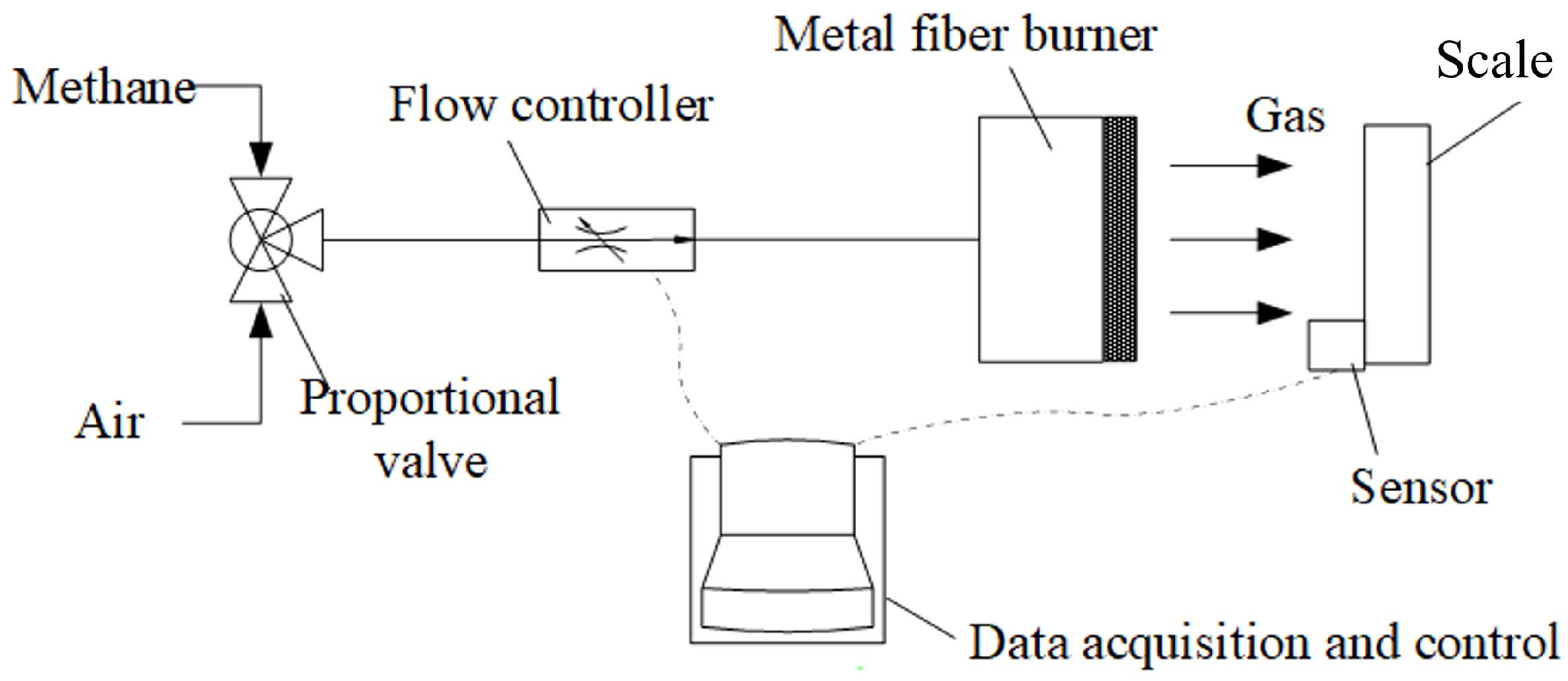
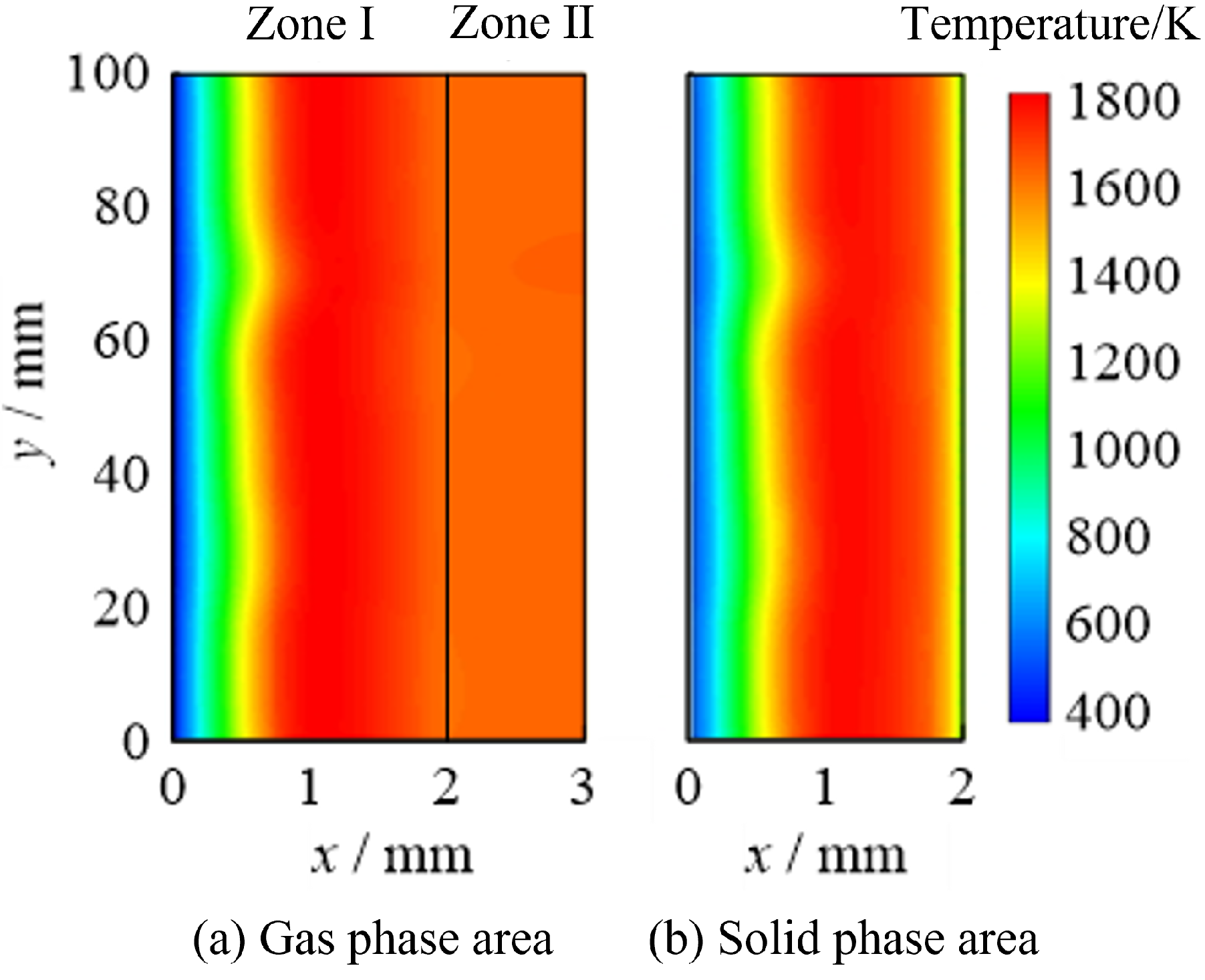


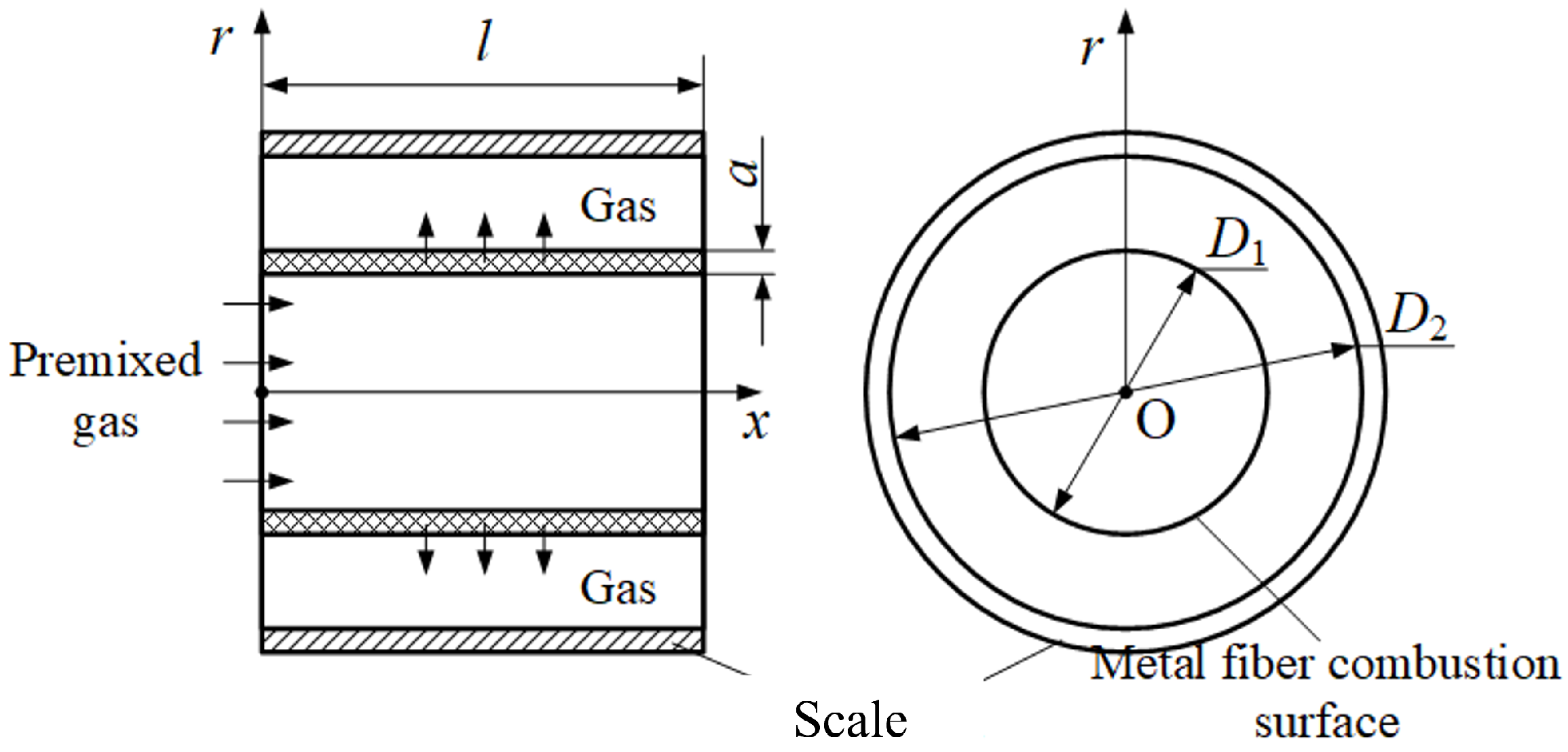
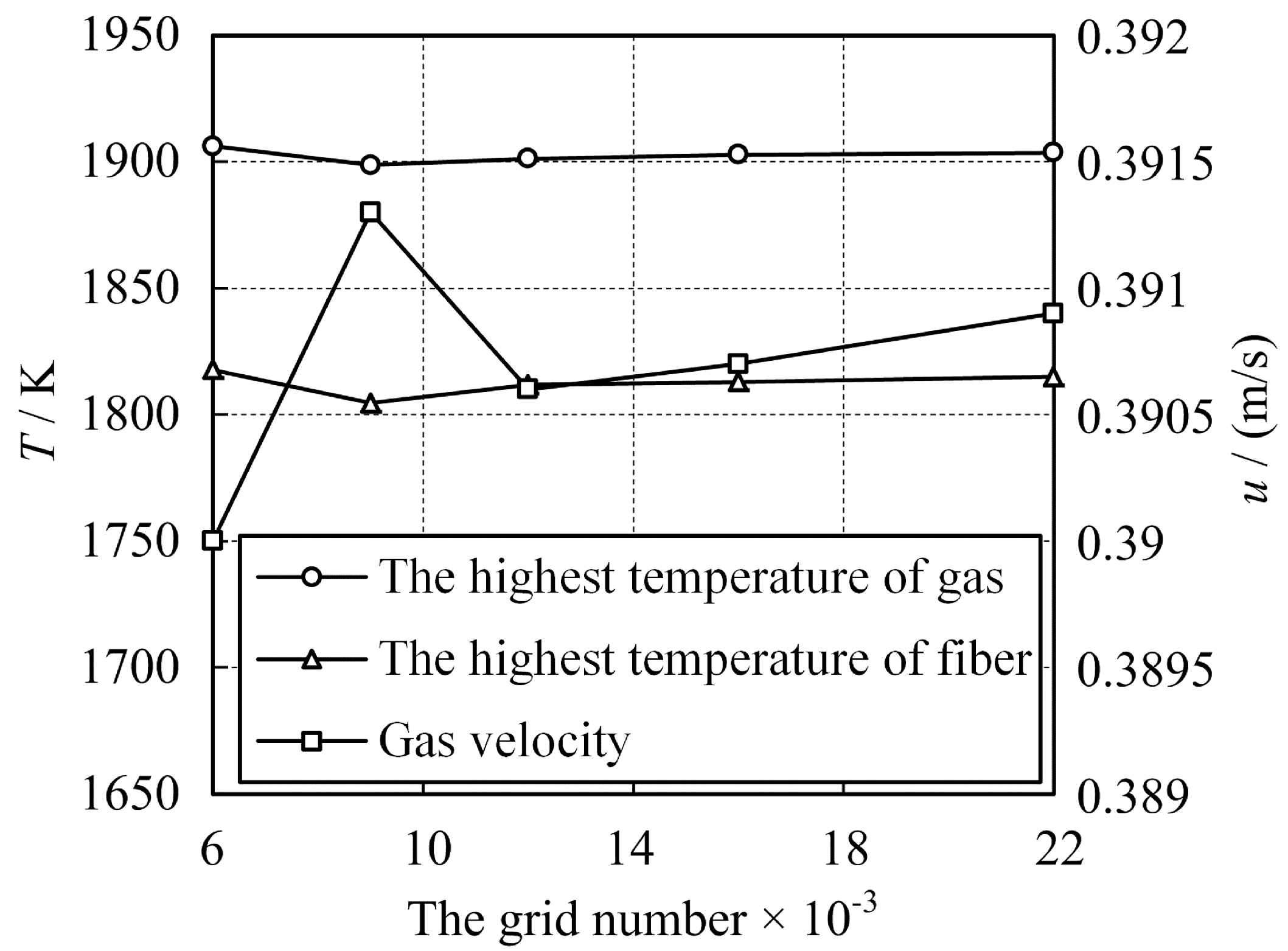
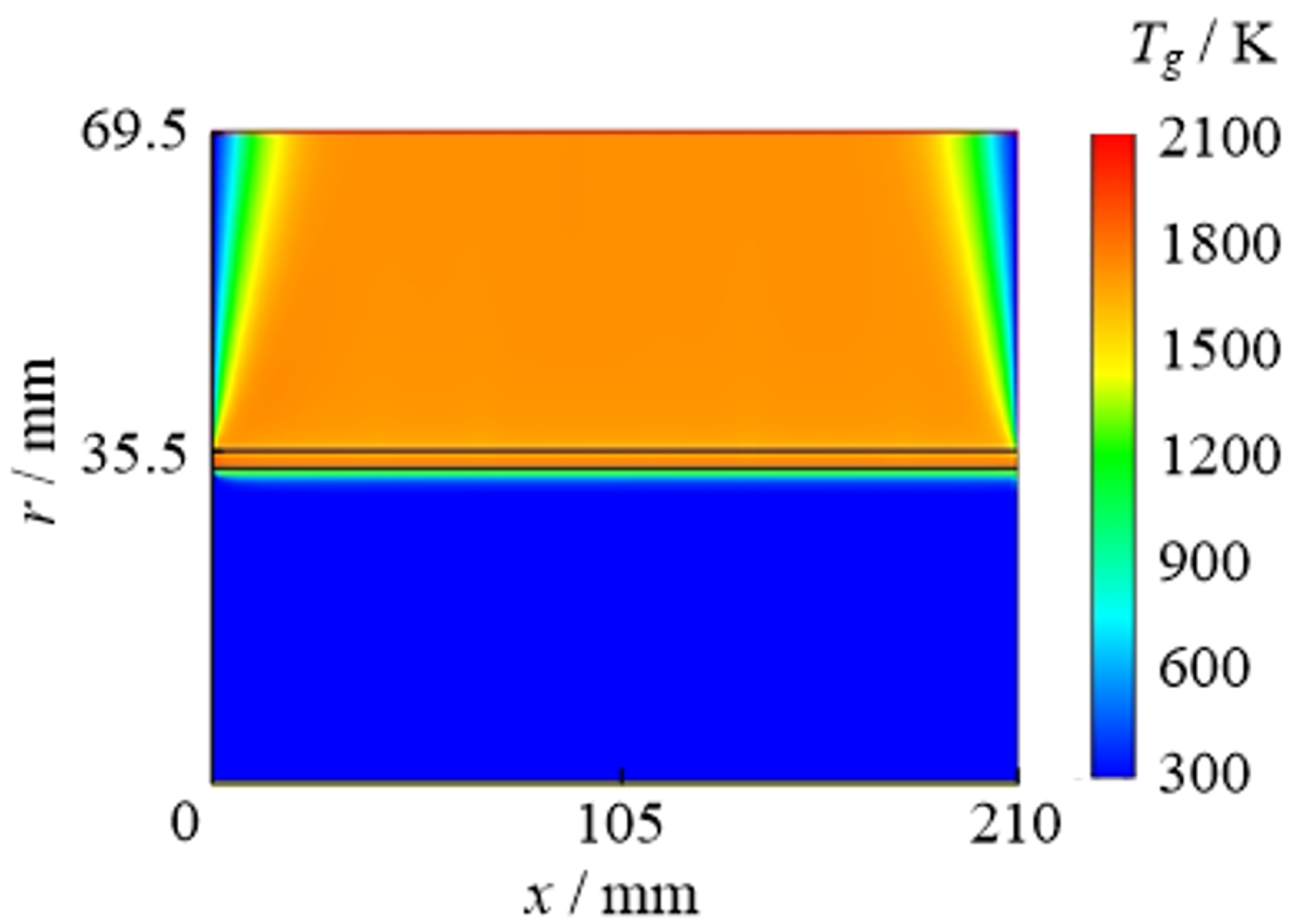
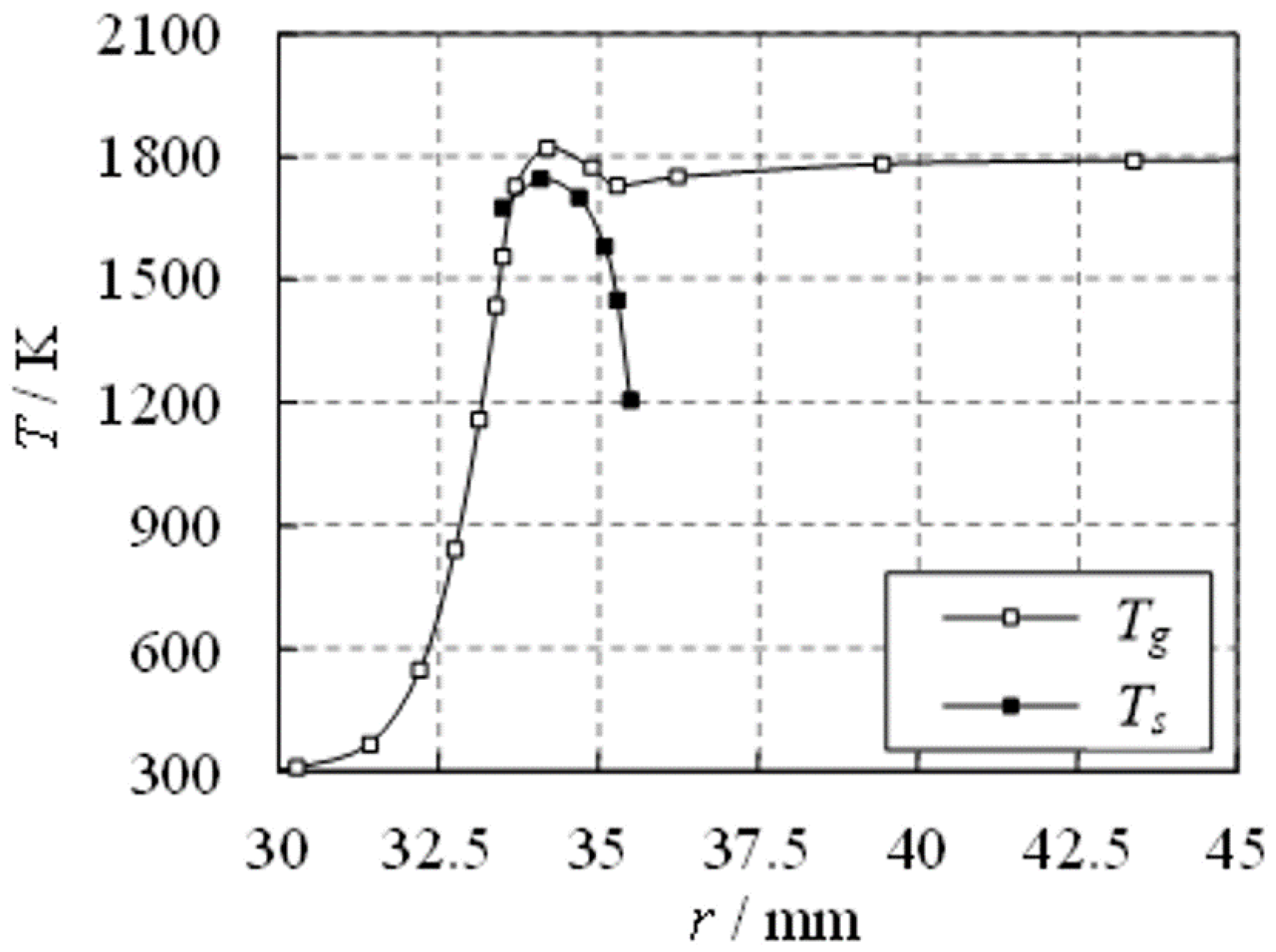
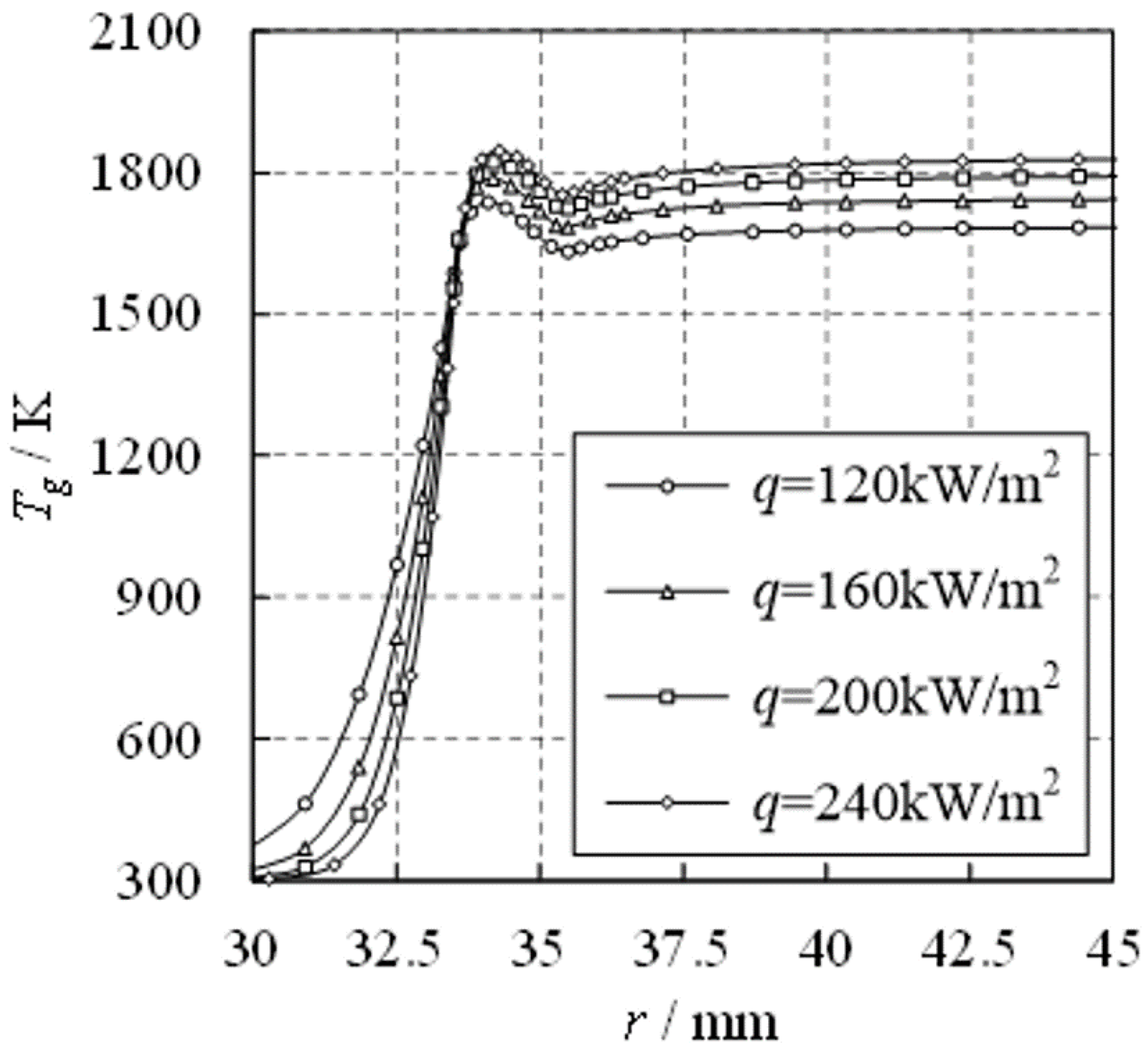

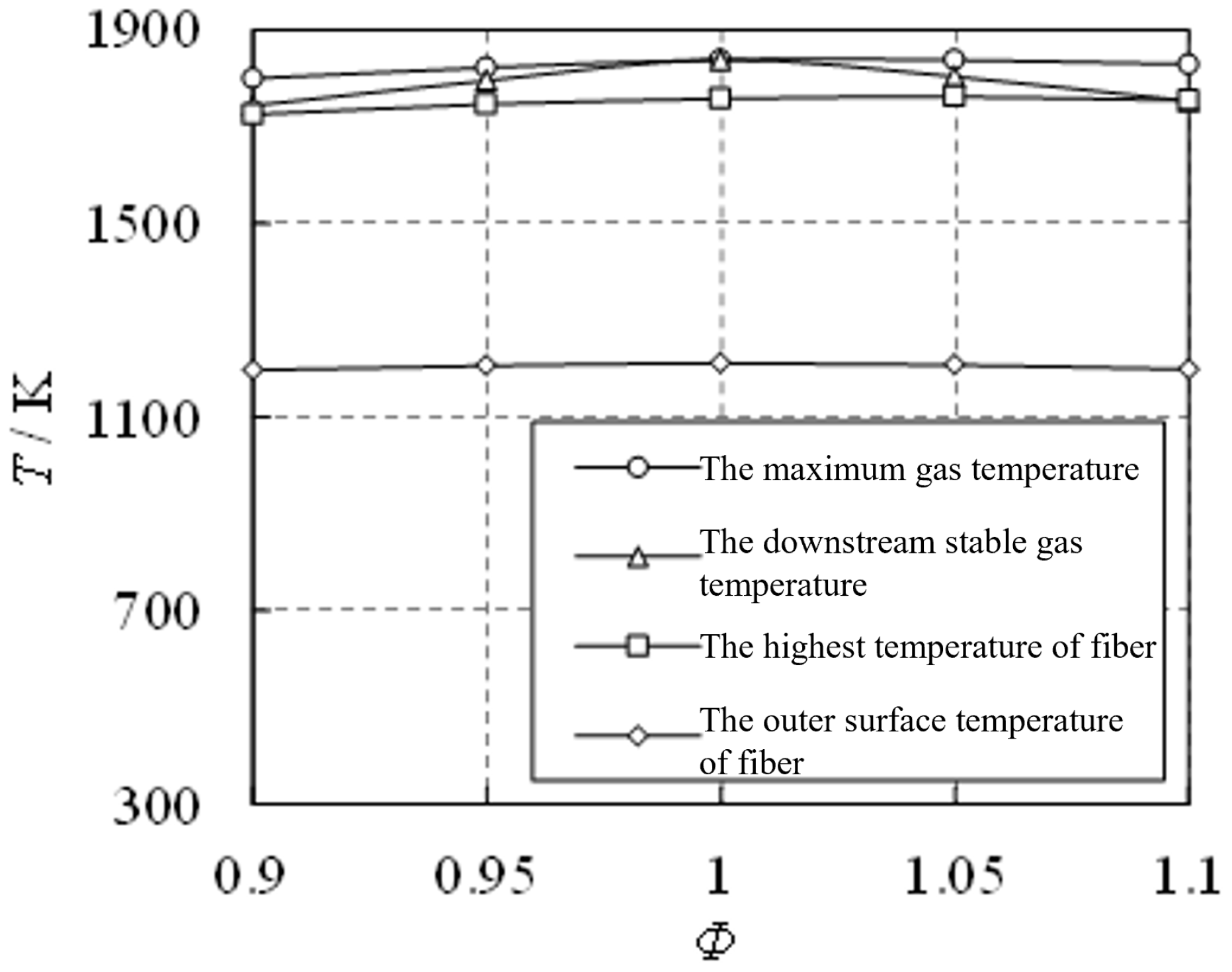
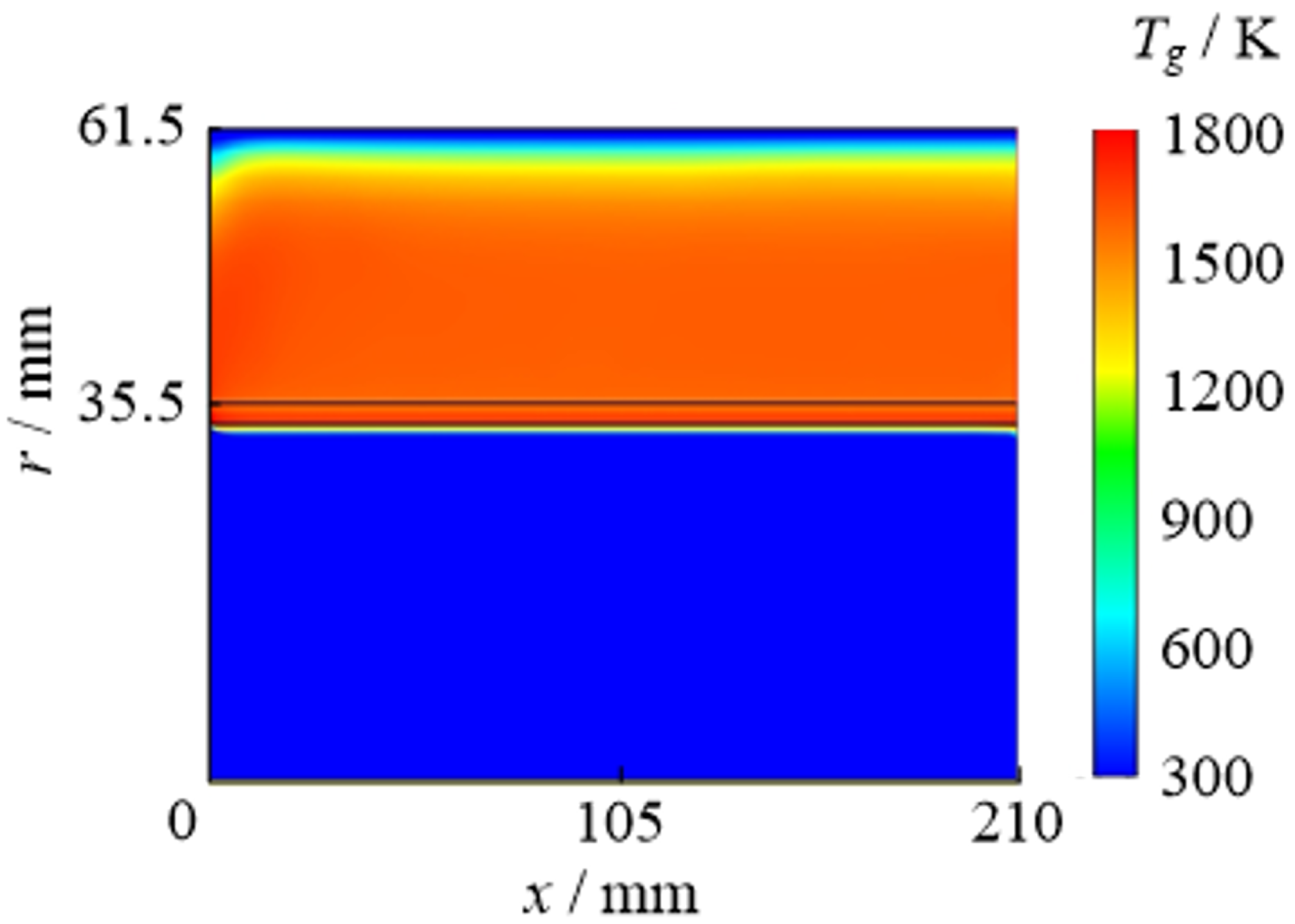


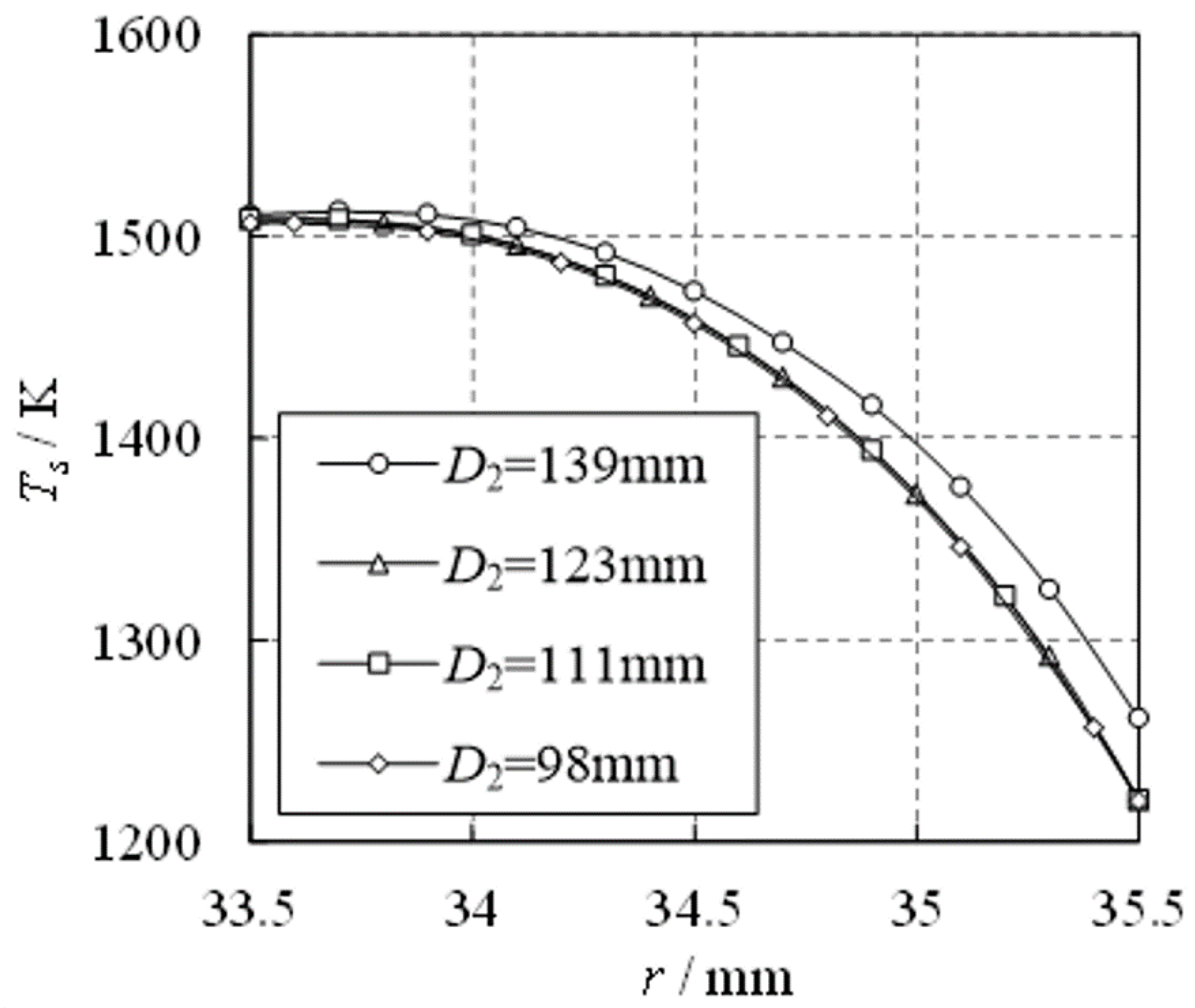
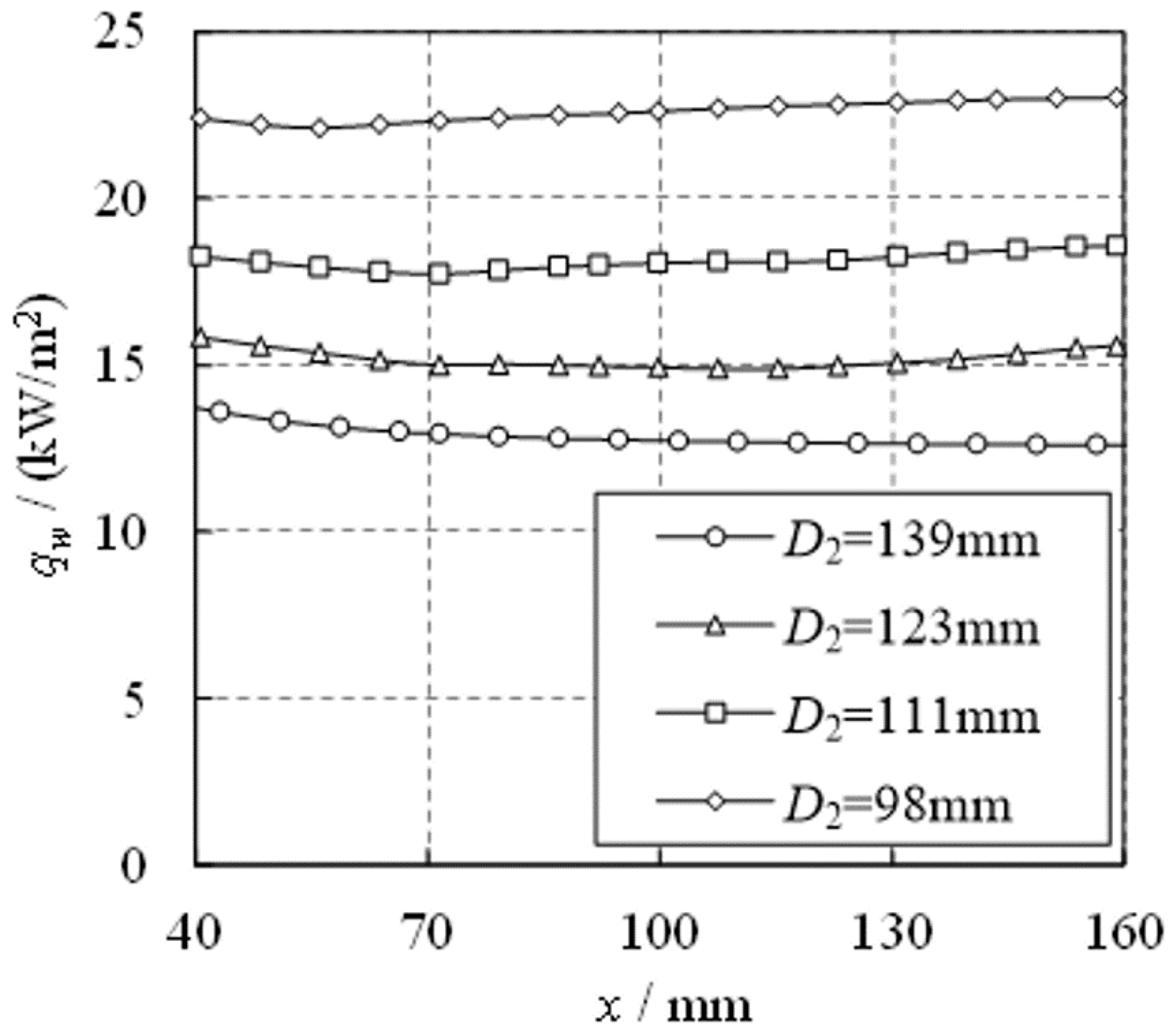
| Parameter Name | Value |
|---|---|
| Cylindrical burner outer diameter (mm) | 71 |
| Length l (mm) | 210 |
| Metal fiber layer thickness a (mm) | 2 |
| Metal fiber material density (kg/m) | 6667 |
| Specific heat capacity of metal fiber material (J/Kg· k) | 422 |
| Thermal conductivity of metal fiber materials (W/m·k) | 1.44 |
| Metal fiber emissivity | 0.59 |
| Metal fiber porosity | 0.3 |
| Metal fiber wire diameter (m) |
Disclaimer/Publisher’s Note: The statements, opinions and data contained in all publications are solely those of the individual author(s) and contributor(s) and not of MDPI and/or the editor(s). MDPI and/or the editor(s) disclaim responsibility for any injury to people or property resulting from any ideas, methods, instructions or products referred to in the content. |
© 2023 by the authors. Licensee MDPI, Basel, Switzerland. This article is an open access article distributed under the terms and conditions of the Creative Commons Attribution (CC BY) license (https://creativecommons.org/licenses/by/4.0/).
Share and Cite
Wang, R.; Qi, B.; Zhou, Y.; A, R.; Dong, S. Numerical Investigation on Combustion and Heating Characteristics of Metal Fiber Burner. Energies 2023, 16, 4301. https://doi.org/10.3390/en16114301
Wang R, Qi B, Zhou Y, A R, Dong S. Numerical Investigation on Combustion and Heating Characteristics of Metal Fiber Burner. Energies. 2023; 16(11):4301. https://doi.org/10.3390/en16114301
Chicago/Turabian StyleWang, Ri, Bin Qi, Yixia Zhou, Rong A, and Sujun Dong. 2023. "Numerical Investigation on Combustion and Heating Characteristics of Metal Fiber Burner" Energies 16, no. 11: 4301. https://doi.org/10.3390/en16114301
APA StyleWang, R., Qi, B., Zhou, Y., A, R., & Dong, S. (2023). Numerical Investigation on Combustion and Heating Characteristics of Metal Fiber Burner. Energies, 16(11), 4301. https://doi.org/10.3390/en16114301





